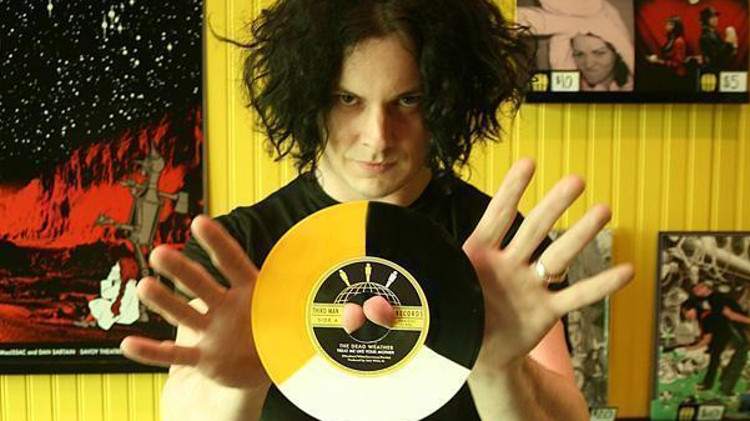All images courtesy of Third Man Records


Jack White is the reason why I started a descent into madness. After already having been a fan of the various groups he was/is a part of and his solo work, it wasn’t until 2014 that my interest in vinyl started to grow. I always associate the vinyl format with Jack, his love for it, and the ways that he has been able to push the limits of the format. His label, Third Man Records, has catered to this market by releasing unique tri-color variants of 7” singles, releasing flexi discs via helium balloon, hiding 7” singles inside of 12” records; the list is endless. Many periods of the digital literacy class I took during my senior year of high school were spent watching videos about Third Man and the Nashville storefront (which I got to visit, the closest thing to a religious experience). This time frame was also significant since it was when I purchased my very first record and I started to build my collection. What started as a very small, bare-bones collection evolved into this never-ending cycle of hunting down colored variants, Japanese pressings, different mixes, bootlegs, audiophile pressings, and many more rabbit holes of minor vinyl minutia; so thanks a lot, Jack…

Jack White is perhaps best known for being one half of The White Stripes with his “sister” Meg. In between album cycles, Jack shifted his focus to form other bands such as The Raconteurs (which brought singer-songwriter Brendan Benson and the rhythm section of The Greenhornes, Patrick Keeler, and Jack Lawrence) and The Dead Weather (including The Kills’ Alison Mosshart, Queens of the Stone Age’s Dean Fertita and Greenhornes’/Raconteurs’ Jack Lawrence). Each of these groups sporadically released albums and toured. Upon the breakup of The White Stripes in 2011, Jack White embarked on a solo career and hasn’t looked back since.
Jack White’s solo career was initially rooted in his standard fusion of blues-rock, folk, and country with his first two albums, 2012’s Blunderbuss and 2014’s Lazaretto. 2018’s Boarding House Reach marked a true departure from his previous work and stands out as being his most bizarre, unorthodox, quirkiest, experimental, and artistic record. Its avant-garde approach and production style challenged many listeners. It went to show that Jack wasn’t apprehensive about stepping out of his analog comfort zone. Working in a digital world, Jack finally embraced the recording wonder of Pro-Tools and abstract production techniques. Many, including myself, wondered if this was going to set a new standard for future Jack White solo work to come in the future or if this was simply an exercise of creative demons. Four years later, here we are and Jack has re-emerged with a new album, Fear of the Dawn. The end result – Jack has been taken back, but with a twist.
The album opens with “Taking Me Back,” with its swelling harmonized guitars and crunching guitar chords. On this track, we have a sound that is very reminiscent of the type of Detroit-infused bluesy garage rock that Jack had prophesied with The White Stripes and his other endeavors. Does the song’s title foreshadow anything? Jack is taking us back to the sound he is best known for and it is the perfect tone-setter for the album. This immediately segues into the album’s title track and it is a down-right assault on the senses. The main riff of this song has a certain swagger that reminded me very much of the song “Over and Over and Over” from Boarding House Reach. The next track, “The White Raven,” has pulsating over-driven guitar riffs and Jack provides his rawest, angsty vocals on this track.

“Hi-De-Ho” opens with dramatic chords and a sample of the Cab Calloway tune of the same name. Once the musical groove is laid down, rapper Q-Tip spits out some amazing bars that draw references to the “Calloway vibe” and name drops notable artists such as Stevie Wonder, Chuck Berry, Minnie Ripperton, and Mariah Carey. The overall vibe of the album is brought up with “Eosophobia” with its uplifting melody line in the chorus and intricate yet inspiring lead guitar work. The next track, “Into The Twilight” is primarily built on samples from Manhattan Transfer’s “Twilight Zone” and “Another Night in Tunisia,” as well as spoken word bits by William S. Borough from “Origin and Theory of the Tape Cut-Ups.” The use of these samples is sculpted quite cleverly with the song’s loose arrangement and sparse but memorable lyrics, “Here in the night, everything’s right.”
Flipping the record over to side two, there is a brief thirty-second instrumental called “Dusk,” which serves as an introduction to the track “What’s The Trick?” This is classic Jack White territory with a bluesy guitar riff played in his distinctive tremolo style delivered with some stream of consciousness, quasi-spoken word lyrics. The chorus of the next song, “That Was Then, This is Now,” sounds like it could’ve been lifted from a Raconteurs song that doesn’t exist with its distinctive harmonized vocals. The song keeps the listener engaged since it shifts rhythm-wise between the verses and choruses and stylistically changes during the middle break. We are then treated to a reprise of “Eosophobia,” which includes a lot of the same musical motifs found in the original song but with different lyrics and more loose guitar work. The song “Morning, Noon and Night” has such an ear-catching melody in the verses that screams a traditional Jack White aesthetic. It makes me miss Meg’s drumming style because this very well could’ve been a White Stripes stomper. It is at this point that the record comes full circle towards the end of the track with a reprise of the motif used in the track “Dusk” and how it merges well with the central groove of the song. The album is wrapped up with its mellowest track, “Shedding My Velvet.” The vibraphone, steady drumbeat, clean guitar licks, and Jack’s soothing vocals create this dream-like quality to the track that makes it such a tranquil comedown from the contrasting harshness of the rest of the record.

Jack White has always had an interesting approach to recording his work, whether it is recording at his own recording studio or working with a stable of session players that also have performed on numerous other Third Man releases. Given the restraints of the past COVID-19 shutdown and not being able to collaborate with other musicians, Jack shakes up the cycle this time around and performs almost all of the instruments (vocals, drums, guitars, bass, synthesizers, and percussion) on almost half of the album’s tracks. Other tracks feature a lineup of bassist Dominic Davis, drummer Daru Jones, and keyboardist Quincy McCrary. It is these musicians that are going to be White’s backing band for the Supply Chain Issues Tour in support of this album. Other notable musicians featured on this record are guitarist Olivia Jean, keyboardist Mark Watrous, and bassist Jack Lawrence. Even Jack’s own daughter Scarlett provides bass on a track!

The physical presentation of this album is truly captivating. The album cover was designed by Jennifer Dionisio and stays true to Jack White’s affinity for the number three, since the colors that adorn his solo releases are blue, white, and black. The vinyl pressing comes with three 8.5×11 inserts full of lyrics, credits, and illustrations. The album and vinyl pressing itself were mastered by Bill Skibbe at Third Man Mastering and believe me, it sounds absolutely magnificent. All of the various vinyl pressings were manufactured at Third Man Pressing. Both of these facilities are located on the premise of Third Man’s Cass Corridor location in Detroit, Michigan. If you were one that has been bitten by the vinyl variant bug, there are plenty of options out there, such as the Target exclusive moon glow white, indie exclusive astronomical blue, Third Man Vault exclusive midnight blue (with a screen-printed cover), Rough Trade exclusive split moon-glow white, and astronomical blue (with a screen printed insert), or you can save yourself the headaches and stick to a basic black copy. For myself, I own the Third Man Vault and indie exclusives since both offers quite unique differences. Once again, thanks a lot, Jack…
It is safe to say that musically, this is Jack White’s heaviest solo album to date. His albums tend to provide a bit of variety for the listener to feast their ears on and this is the first time that each song hits hard. To hark back to what I had said about the album’s opener “Taking Me Back,” this album has a sound that is very reminiscent of the type of Detroit-infused bluesy garage rock that Jack had prophesied early on in his career. With that said, I do feel that the experimental nature that was found on Boarding House Reach can still be found on this record in terms of the production style and the arrangements of the songs. This record shows Jack embracing his roots but within the context of the now. All in all, Jack White’s Fear of the Dawn takes him back.

Interested in learning more about Jack White’s newest record, Fear of the Dawn? Hit the link below:
Be sure to check out the full archives of The Record Spinner, by Dylan Peggin, here: https://vinylwritermusic.wordpress.com/the-record-spinner-archives/





Leave a Reply